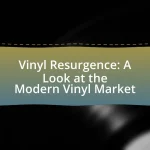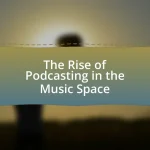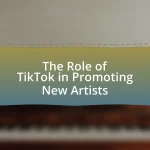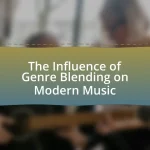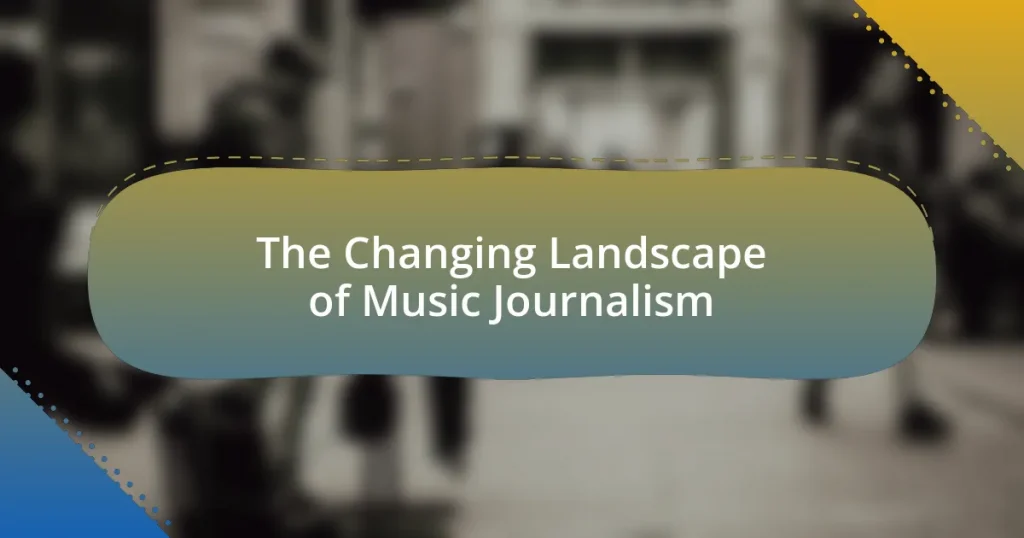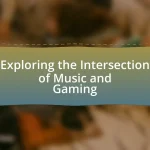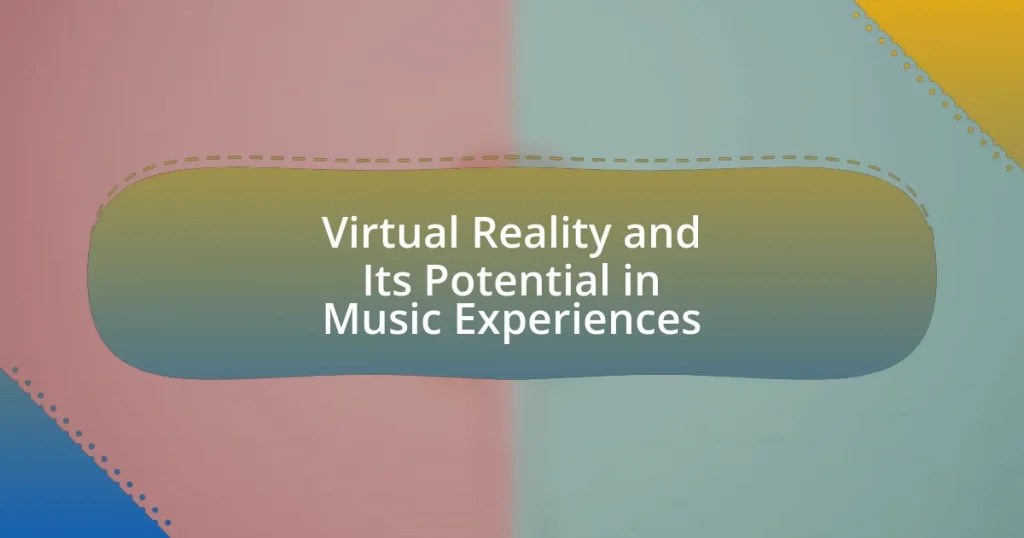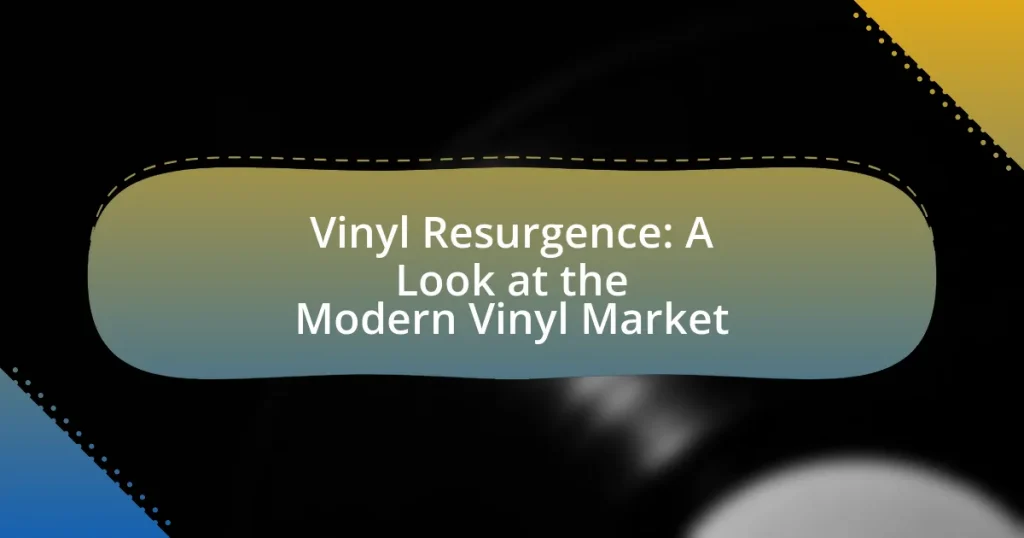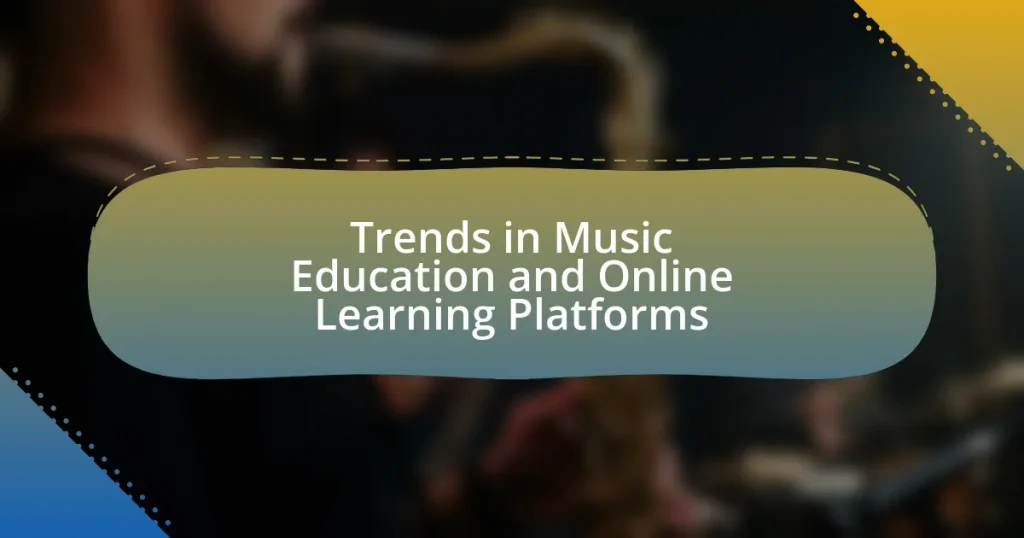The article examines the evolving landscape of music journalism, highlighting the transition from traditional print media to digital platforms that facilitate immediate information dissemination and audience engagement. It discusses the historical factors that shaped music journalism, the impact of technological advancements, and the characteristics of modern reporting, including the role of social media and influencers. Additionally, the article addresses the challenges faced by music journalism today, such as issues of credibility and financial sustainability, while exploring future trends and best practices for aspiring journalists in this dynamic field.
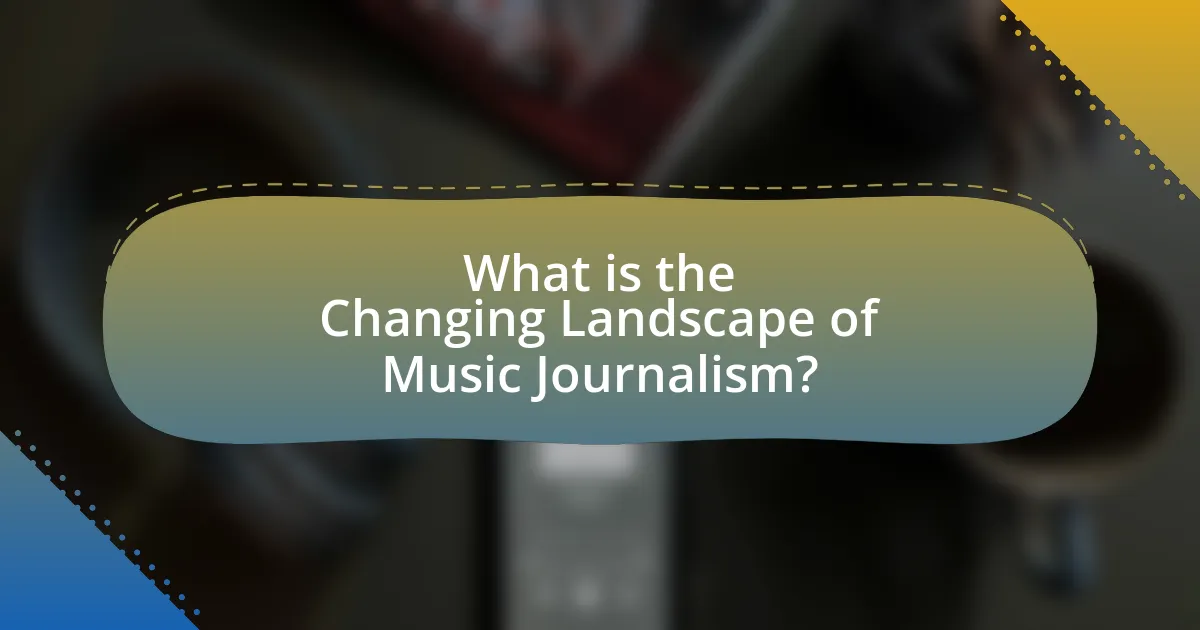
What is the Changing Landscape of Music Journalism?
The changing landscape of music journalism is characterized by the shift from traditional print media to digital platforms, significantly altering how music is reported and consumed. This transition has led to the rise of online publications, blogs, and social media, which allow for immediate dissemination of information and greater audience engagement. According to a 2021 report by the Pew Research Center, 86% of Americans now get their news from digital sources, highlighting the decline of print journalism. Additionally, the democratization of content creation through platforms like YouTube and TikTok has enabled artists to bypass traditional media gatekeepers, further transforming the industry. This evolution reflects broader trends in media consumption and the increasing importance of digital literacy among both journalists and audiences.
How has music journalism evolved over the years?
Music journalism has evolved significantly from its origins in print media to a predominantly digital landscape. Initially, music journalism focused on album reviews and artist interviews in magazines and newspapers, with notable publications like Rolling Stone and NME leading the way. The rise of the internet in the late 1990s and early 2000s transformed music journalism, enabling instant access to information and the emergence of music blogs and online platforms. This shift allowed for diverse voices and perspectives, as independent writers and fans could share their insights without traditional gatekeeping. Furthermore, social media has played a crucial role in shaping music journalism by facilitating real-time reporting and audience engagement, exemplified by platforms like Twitter and Instagram where artists directly communicate with fans. The transition to digital has also led to the rise of multimedia content, including podcasts and video interviews, enriching the storytelling aspect of music journalism.
What historical factors influenced the development of music journalism?
The development of music journalism was influenced by several historical factors, including the rise of popular music genres, technological advancements in media, and the cultural shifts of the 20th century. The emergence of genres like jazz, rock and roll, and hip-hop created a demand for coverage and critique, leading to the establishment of dedicated music publications. Technological advancements, such as the printing press and later, radio and television, expanded the reach of music journalism, allowing for broader dissemination of music reviews and artist interviews. Additionally, cultural movements, including the counterculture of the 1960s, prompted a more critical and engaged approach to music journalism, as writers began to explore the social and political implications of music. These factors collectively shaped the evolution of music journalism into a distinct field that reflects both artistic expression and societal trends.
How have technological advancements impacted music journalism?
Technological advancements have significantly transformed music journalism by enabling faster dissemination of information and enhancing audience engagement. The rise of digital platforms, such as social media and music streaming services, has allowed journalists to reach wider audiences instantly, facilitating real-time reporting and interaction. For instance, platforms like Twitter and Instagram enable journalists to share news, reviews, and interviews directly with fans, creating a more dynamic and immediate form of communication. Additionally, the accessibility of music through streaming services has shifted the focus of journalism from album reviews to broader discussions about trends and artist narratives, reflecting changes in how audiences consume music. This evolution is supported by data indicating that over 60% of music listeners now discover new music through social media, highlighting the critical role of technology in shaping music journalism today.
What are the key characteristics of modern music journalism?
Modern music journalism is characterized by its digital-first approach, diverse platforms, and emphasis on audience engagement. The shift to online mediums allows for real-time reporting and instant feedback, which enhances the interaction between journalists and readers. Additionally, modern music journalism often incorporates multimedia elements, such as videos and podcasts, to enrich storytelling and provide a more immersive experience. The rise of social media has also democratized music criticism, enabling a wider range of voices and perspectives to be heard, thus reflecting a broader cultural landscape. These characteristics highlight the evolution of music journalism in response to technological advancements and changing consumer behaviors.
How do digital platforms shape the way music is reported?
Digital platforms significantly shape the way music is reported by enabling real-time dissemination of information and fostering direct artist-to-fan communication. These platforms, such as social media and streaming services, allow artists to share updates, releases, and personal insights instantly, which traditional media outlets cannot match. For instance, platforms like Twitter and Instagram have become primary sources for breaking news about music releases and events, often leading to a shift in how journalists gather and report information. According to a 2021 study by the Pew Research Center, 53% of U.S. adults reported getting news about music from social media, highlighting the growing influence of these platforms on music journalism. This shift has resulted in a more democratized reporting landscape, where independent artists can bypass traditional media gatekeepers and engage directly with their audience, fundamentally altering the dynamics of music reporting.
What role do social media and influencers play in music journalism?
Social media and influencers significantly shape music journalism by providing platforms for immediate content dissemination and audience engagement. These channels allow journalists to share news, reviews, and interviews directly with fans, bypassing traditional media gatekeepers. For instance, platforms like Twitter and Instagram enable real-time updates and interactions, fostering a more dynamic relationship between artists, journalists, and audiences. Influencers, often with large followings, can amplify music coverage by promoting artists and their work, thus impacting public perception and consumption patterns. According to a 2021 study by the Pew Research Center, 72% of teens report using social media for music discovery, highlighting its critical role in shaping music journalism today.
Why is music journalism important in today’s music industry?
Music journalism is important in today’s music industry because it serves as a critical bridge between artists and audiences, facilitating the discovery and promotion of new music. This role is essential for emerging artists who rely on music journalists to provide exposure and credibility, which can significantly impact their career trajectories. For instance, a favorable review or feature in a reputable publication can lead to increased streaming numbers and concert attendance, as evidenced by studies showing that media coverage correlates with higher sales and visibility. Additionally, music journalism helps to contextualize the cultural significance of music, offering insights into trends and movements that shape the industry, thereby enriching the listener’s experience and understanding.
How does music journalism affect artist promotion and discovery?
Music journalism significantly impacts artist promotion and discovery by providing critical exposure and credibility to emerging and established musicians. Through reviews, interviews, and features, music journalists highlight artists’ work, which can lead to increased visibility in a crowded market. For instance, a favorable review in a prominent publication can boost an artist’s streaming numbers and social media following, as evidenced by a study from the University of Southern California, which found that artists featured in major music outlets saw a 30% increase in their online engagement. Additionally, music journalism often shapes public perception and can influence industry gatekeepers, such as record labels and booking agents, thereby facilitating opportunities for live performances and collaborations.
What impact does music journalism have on audience engagement?
Music journalism significantly enhances audience engagement by providing critical insights, reviews, and narratives that connect listeners to artists and their work. This form of journalism fosters a deeper understanding of music by contextualizing it within cultural and social frameworks, which encourages audiences to explore and discuss the music more actively. For instance, studies have shown that music reviews can increase album sales by up to 30%, indicating that informed commentary directly influences listener behavior and interest. Additionally, platforms like Pitchfork and Rolling Stone have demonstrated that engaging content can create communities around music genres, further amplifying audience interaction and loyalty.
What challenges does music journalism face today?
Music journalism today faces significant challenges, primarily due to the rise of digital media and social platforms. Traditional outlets struggle to compete with the immediacy and accessibility of online content, leading to a decline in print publications and a shift in revenue models. According to a 2021 report by the Pew Research Center, 70% of Americans now get their news from social media, which diminishes the audience for dedicated music journalism. Additionally, the proliferation of user-generated content has blurred the lines between professional journalism and amateur commentary, complicating the credibility of music reviews and reporting. This environment pressures journalists to produce content rapidly, often at the expense of in-depth analysis and quality.
How do issues of credibility and misinformation affect music journalism?
Issues of credibility and misinformation significantly undermine music journalism by eroding trust between journalists and their audience. When music journalists publish inaccurate information or fail to verify sources, it leads to the spread of false narratives about artists, albums, and events. For instance, a 2020 study by the Pew Research Center found that 64% of Americans believe that misinformation has caused confusion about important issues, including cultural topics like music. This confusion can result in misinformed public perceptions, damaging artists’ reputations and affecting their careers. Furthermore, the rise of social media has amplified the speed at which misinformation spreads, making it crucial for music journalists to adhere to rigorous fact-checking standards to maintain their credibility and the integrity of the music industry.
What financial challenges are impacting music journalism outlets?
Music journalism outlets are facing significant financial challenges primarily due to declining advertising revenues and the shift to digital platforms. Traditional print media has seen a drastic reduction in ad spending, with a 2021 report indicating that U.S. newspaper advertising revenue fell to $10.3 billion, down from $49.4 billion in 2005. Additionally, the rise of free content on digital platforms has led to decreased subscription rates and a struggle to monetize content effectively. This financial strain has resulted in layoffs and reduced coverage, impacting the overall quality and diversity of music journalism.
How can music journalists adapt to the changing landscape?
Music journalists can adapt to the changing landscape by embracing digital platforms and utilizing social media for content distribution. As traditional print media declines, the rise of online platforms necessitates that journalists develop skills in multimedia storytelling, including video and podcasting. According to a 2021 report by the Pew Research Center, 86% of Americans consume news online, highlighting the importance of digital engagement. Additionally, music journalists should focus on building personal brands and engaging directly with audiences through interactive content, which fosters community and loyalty. This shift towards digital and interactive formats is essential for maintaining relevance in an evolving media environment.
What skills are essential for modern music journalists?
Essential skills for modern music journalists include strong writing abilities, digital literacy, and a deep understanding of music theory and culture. Writing skills are crucial for crafting engaging articles and reviews that resonate with audiences. Digital literacy is increasingly important as music journalism shifts to online platforms, requiring proficiency in social media, content management systems, and multimedia storytelling. A solid grasp of music theory and cultural context enables journalists to analyze and critique music effectively, providing insightful commentary that enhances their credibility. These skills collectively empower music journalists to navigate the evolving landscape of the industry successfully.
How can music journalists leverage new technologies for storytelling?
Music journalists can leverage new technologies for storytelling by utilizing multimedia platforms, social media, and data analytics to enhance their narratives. These tools allow journalists to create immersive experiences that engage audiences more effectively than traditional text-based articles. For instance, incorporating video interviews, interactive timelines, and audio clips can provide richer context and emotional depth to stories. Additionally, social media platforms enable real-time audience interaction and feedback, which can shape ongoing narratives. Data analytics can help journalists understand audience preferences and tailor content accordingly, ensuring relevance and engagement. This approach aligns with the evolving consumption habits of audiences, who increasingly favor dynamic and interactive content over static formats.
What are the future trends in music journalism?
Future trends in music journalism include the rise of multimedia storytelling, increased use of data analytics, and a focus on niche communities. Multimedia storytelling allows journalists to engage audiences through various formats such as video, podcasts, and interactive articles, enhancing the overall experience. Data analytics enables journalists to understand audience preferences and tailor content accordingly, leading to more personalized reporting. Additionally, as music consumption becomes more fragmented, there is a growing emphasis on covering niche genres and local scenes, allowing for deeper connections with specific audiences. These trends reflect the evolving nature of media consumption and the need for music journalism to adapt to changing technologies and audience behaviors.
How might artificial intelligence influence music journalism?
Artificial intelligence might influence music journalism by automating content creation and enhancing data analysis. AI algorithms can generate reviews, summaries, and articles based on data from streaming platforms, social media, and listener preferences, allowing for faster and more personalized content delivery. For instance, platforms like Jukedeck and OpenAI’s GPT-3 have demonstrated capabilities in generating music-related articles and reviews, showcasing the potential for AI to streamline the writing process. Additionally, AI can analyze trends and audience engagement metrics, providing journalists with insights that inform their coverage and help them tailor their content to meet audience demands. This shift towards data-driven journalism can lead to more relevant and timely reporting in the music industry.
What emerging formats are shaping the future of music reporting?
Emerging formats shaping the future of music reporting include podcasts, video content, and social media platforms. Podcasts have gained popularity due to their ability to provide in-depth discussions and interviews with artists, allowing for a more personal connection with audiences. Video content, particularly on platforms like YouTube and TikTok, enables visual storytelling and engagement, making music reporting more dynamic and accessible. Social media platforms facilitate real-time updates and interactions, allowing journalists to share news and insights instantly, thus transforming traditional reporting methods. These formats reflect the evolving preferences of audiences for more interactive and multimedia-rich content in music journalism.
What best practices should aspiring music journalists follow?
Aspiring music journalists should prioritize developing strong writing skills, staying informed about music trends, and building a network within the industry. Strong writing skills are essential for creating engaging and informative content that resonates with readers. Staying informed about music trends allows journalists to provide relevant insights and critiques, which is crucial in a rapidly evolving industry. Building a network helps in gaining access to artists, industry professionals, and exclusive content, enhancing the journalist’s credibility and reach. According to a survey by the Music Journalism Association, 78% of successful music journalists attribute their success to networking and industry connections.
How can aspiring journalists build a strong portfolio in music journalism?
Aspiring journalists can build a strong portfolio in music journalism by creating diverse content that showcases their writing skills, critical analysis, and understanding of the music industry. This can include writing album reviews, artist interviews, concert coverage, and opinion pieces on music trends.
To enhance their portfolio, journalists should actively seek opportunities to publish their work on various platforms, such as music blogs, online magazines, and social media. Engaging with established music publications and contributing guest articles can also provide valuable exposure.
Additionally, attending music events and festivals allows journalists to network with industry professionals and gain firsthand experience, which can be highlighted in their portfolio. According to a 2021 survey by the Music Journalism Association, 75% of successful music journalists emphasized the importance of having a varied portfolio that reflects both their unique voice and a broad understanding of different music genres.
What networking strategies are effective for music journalists?
Effective networking strategies for music journalists include building relationships with artists, engaging with industry professionals, and utilizing social media platforms. Establishing connections with artists can lead to exclusive interviews and insights, enhancing the journalist’s credibility and access to information. Engaging with industry professionals, such as publicists and record label representatives, can provide valuable resources and opportunities for collaboration. Additionally, leveraging social media platforms like Twitter and Instagram allows journalists to interact directly with their audience and industry figures, fostering a community that can lead to further networking opportunities. These strategies are supported by the fact that personal connections often result in more significant opportunities in the competitive field of music journalism.

